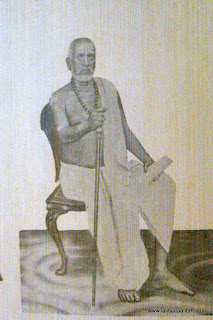उच्चैः प्रापयसे पदं लघुतरानर्थानधस्ताद्गुरून्
जिह्वां लोलतमां बिभर्षि कुटिला विस्रंसिनस्ते गुणाः ।
अप्येवं धट तारतम्यकलनाचातुर्यधौरेयता
त्वय्याधीयत येन सर्वविदसौ धातैव किं ब्रूमहे ॥
The purport of the stanza is this : The balance has a wavering needle and loose chains; it lifts up the empty things and brings down the weightier ones. Nevertheless, the all-knowing ruler has made it the supreme authority in assessing the comparative value of all objects in the world. This was an implied criticism of the unbalanced patronage of the king. The king was however pleased with the poet and asked him to compose a poem on the model of anyApadeshashataka (अन्यापदेशशतकम्) of nIlakaNTha-dIxita (नीलकण्ठदीक्षितः).
kIrtivilAsa (कीर्त्तिवलासः) is a champu-kAvya (चम्पूकाव्यम्) in florid style with a wealth og imagery, on the greatness of Ailyam tirunAl (आइल्यं तिरुनाल्). It describes the capital city, the royal court and the prominent scholars that adorned the sadas (सदस्). Available mss. of the work break off with the first ullAsa (प्रथमोल्लासः).
tulAbhAraprabandha (तुलाभारप्रबन्धः) portrays the tulApuruShadAna (तुलापुरुषदानम्) ceremony celebrated by vishAkham tirunAl (विशाखं तिरुनाल्). The ceremony consists in weighing oneself in a balance with gold which would later be distributed to deserving persons. There are in this work one hundred and odd stanzas in different meters, some of them with verbal devices and insertion of draviDian words (द्रविडपदानि) without affecting the meaning.
gauNasamAgama (गौणसमागमः) is a small work painting the pageant in the capital with the colors of imagination, when Lord Napier, Governor of Madras, visited the State in 1863.

